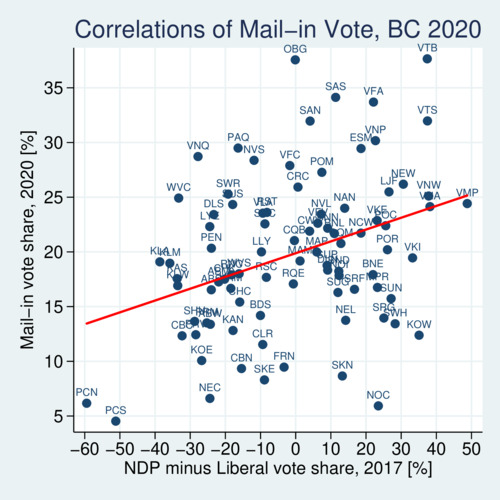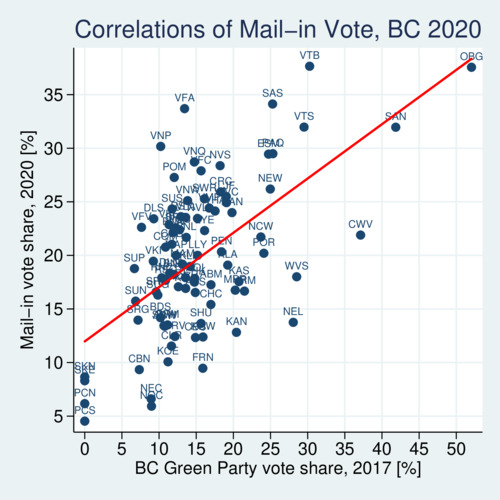Because of the COVID19 pandemic, British Columbia's October 24 election has seen an unprecedented number of mail-in ballots. According to interim statistics released by Elections BC on October 23, an unprecedented 724,279 registered voters have been issued a vote-by-mail package, about 21% of all registered voters. While 69% of mail-in-votes had already been returned, more are still in transit thorugh Canada Post or may have been dropped off at a district electoral office or voting place. Because of pandemic precautions, Elections BC will only begin counting mail-in votes 13 days after Election Day, and final results are expected to become available around November 16. All in all, about a third of all votes are expected to be cast by mail this year. Voter turnout overall has been rather low—the Globe and Mail even called it a miserable turnout.
Preliminary results from election night have the NDP in the lead with 55 seats, far ahead of the BC Liberals with 29 seats. BC's Green Party is expected to hold 3 seats. We should not expect any big surprises from the mail in votes. Only four ridings have narrow victories: two each for the Liberals (Vernon-Monashee and Abbotsford-Mission lead with about 1% vote share) and two for the NDP (Chilliwack-Kent with 1.2% and Richmond South Centre with 1.5%). For ridings to swing to another party, the mail-in ballots would need to be strongly biased in one direction or another. As I will show below, the evidence for such partisan bias is weak.
If there is any bias at all, it would benefit the Green Party the most, and somewhat less the NDP. There is no indication that Liberal candidates can expect a big boost from mail-in votes that would turn around electoral results. If there is indeed a weak NDP bias in the mail-in vote, which my numbers below suggest, it may turn the two narrow BC Liberal leads in Vernon-Monashee and Abbotsford-Mission in favour of the NDP.
To see if there is any obvious bias in the mail-in ballots we can turn to the partisan leaning across constituencies in 2017 as a benchmark and see how this leaning correlates with the share of mail-in ballots that were issued. The null hypothesis is that the partisan bias in a constituency should have no effect on the share of mail-in ballots. However, if voters of a particular party request mail-in ballots more often than voters of another party, we should see a postive correlation between vote bias and mail-in vote sahre.
The two diagrams below show the correlation of mail-in ballots with measures of partisan bias. The first diagram has the vote share difference between the NDP and Liberals in 2017, with NDP-leaning constituencies on the right and BC Liberal-leaning constituencies on the left. It turns out that there is a weak positive correlation that associates a higher NDP-minus-Liberal share with higher mail-in vote share. In other words, voters in NDP strongholds seem to be more eager mail-in voters, and this tends to favour the NDP.

click on image for high-resolution PDF version
A list of constituency codes is shown at the end of this blog.
But how strong is this effect? Statistically, a 10%-point increase in the NDP-Liberal vote share is associated with a 1%-point increase in the mail-in vote share. That is not a very large effect. Even a 50%-point shift in the NDP-Liberal vote share is only suggesting a 5%-point increase in the mail-in vote share.
The partisan effect is actually strongest for the Green Party. The diagram below shows that an increase in the vote share of the Green Party by 1%-point is associated with an 0.5%-point increase in the mail-in vote share. The vote share for the BC Greens covers a significant range, up to 50% in its erstwhile stronghold of Oak Bay Gordon Head, that they appear to have lost in this election. Comparing constituences where the Green Party has 25% of the vote share against those where they only have a 5% vote share, the proportion of mail-in ballots is 10%-points higher on average.

click on image for high-resolution PDF version
A list of constituency codes is shown at the end of this blog.
However, even for the Green Party any beneficial effect will not matter, as the Green Party does not lead in any close races. If anything, the mail-in ballots can be expected to solidify their victories in the three ridings they have won.
Statistically speaking, a model that explains the 2020 mail-in vote share with both the Green Party Share and the NDP-over-Liberal difference in the 2017 votes explains about 44% of the variation in mail-in-vote shares. Both efects are statistically significant (the t-statistics are 3.12 and 6.49, respectively), but their political significance is small.
Another way to look at correlations is thorugh the lens of the vote changes that have been observed on Election Day. If there was a strong hidden partisan bias in the mail-in vote for one party, that party's losses should be larger with a higher mail-in vote share, or its gains should be smaller with a higher mail-in vote share. In other words, there needs to be a negative correlation between the mail-in vote share and the 2020 gains seen on Election Day. For the BC Liberals, there is no statistically significant correlation that points to hidden pockets of Liberal support in the mail-in votes.
If the BC Liberals are hoping for a magic turnaround of election results through the mail-in ballots, they are very likely going to be very disappointed. The statistical analysis does not point in a favourable direction for them. The likelier scenario is that BC's NDP may end up with 56 or 57 instead of 55 seats. There can be no doubt at all that John Horgan will lead a majority government for the next four years.
The aforementioned correlations are of course no proof of partisan bias in the election. Tehre is research from colleagues at Princeton that universal vote-by-mail has no impact on partisan turnout or vote share. In the upcoming election in the United States, a New York Times analysis shows that vote-by-mail does not favour Democrats. However, there is evidence that more democrats request mail ballots in key states. There does appear to be a self selection effect that left-leaning voters are more likely to vote by mail compared to right-leaning voters. In the United States this could indeed lead to a greater importance of mail-in ballots. In the same pattern (left-leaning voters are more likely to vote by mail) holds true in British Columbia—as the above correlations suggest—we can expect a small shift towards left-leaning parties in the vote counts when mail-in ballots are opened in November.
* * *
Below is a list of the 87 three-letter constituency codes that are used in the diagrams above.
| Code : Constituency | Code : Constituency | Code : Constituency |
|---|---|---|
| ABS: Abbotsford South | LLY: Langley | SAS: Saanich South |
| ABW: Abbotsford West | LYE: Langley East | SHU: Shuswap |
| ABM: Abbotsford-Mission | MAM: Maple Ridge-Mission | SKE: Skeena |
| BDS: Boundary-Similkameen | MAP: Maple Ridge-Pitt Meadows | SKN: Stikine |
| BNN: Burnaby North | MPR: Mid Island-Pacific Rim | SUS: Surrey South |
| BND: Burnaby-Deer Lake | NAN: Nanaimo | SRC: Surrey-Cloverdale |
| BNE: Burnaby-Edmonds | NCW: Nanaimo-North Cowichan | SRF: Surrey-Fleetwood |
| BNL: Burnaby-Lougheed | NEC: Nechako Lakes | SRG: Surrey-Green Timbers |
| CBN: Cariboo North | NEL: Nelson-Creston | SUG: Surrey-Guildford |
| CBC: Cariboo-Chilcotin | NEW: New Westminster | SUN: Surrey-Newton |
| CHC: Chilliwack | NOC: North Coast | SUP: Surrey-Panorama |
| CHK: Chilliwack-Kent | NOI: North Island | SWH: Surrey-Whalley |
| CLR: Columbia River-Revelstoke | NVL: North Vancouver-Lonsdale | SWR: Surrey-White Rock |
| CQB: Coquitlam-Burke Mountain | NVS: North Vancouver-Seymour | VFA: Vancouver-Fairview |
| CQM: Coquitlam-Maillardville | OBG: Oak Bay-Gordon Head | VFC: Vancouver-False Creek |
| CRC: Courtenay-Comox | PAQ: Parksville-Qualicum | VFV: Vancouver-Fraserview |
| CWV: Cowichan Valley | PCN: Peace River North | VHA: Vancouver-Hastings |
| DLN: Delta North | PCS: Peace River South | VKE: Vancouver-Kensington |
| DLS: Delta South | PEN: Penticton | VKI: Vancouver-Kingsway |
| ESM: Esquimalt-Metchosin | POC: Port Coquitlam | VLA: Vancouver-Langara |
| FRN: Fraser-Nicola | POM: Port Moody-Coquitlam | VMP: Vancouver-Mount Pleasant |
| KAN: Kamloops-North Thompson | POR: Powell River-Sunshine Coast | VNP: Vancouver-Point Grey |
| KAS: Kamloops-South Thompson | PRM: Prince George-Mackenzie | VNQ: Vancouver-Quilchena |
| KLW: Kelowna West | PRV: Prince George-Valemount | VNW: Vancouver-West End |
| KLA: Kelowna-Lake Country | RNC: Richmond North Centre | VRM: Vernon-Monashee |
| KLM: Kelowna-Mission | RSC: Richmond South Centre | VTB: Victoria-Beacon Hill |
| KOE: Kootenay East | RQE: Richmond-Queensborough | VTS: Victoria-Swan Lake |
| KOW: Kootenay West | RST: Richmond-Steveston | WVC: West Vancouver-Capilano |
| LJF: Langford-Juan de Fuca | SAN: Saanich North and the Islands | WVS: West Vancouver-Sea to Sky |
![[Sauder School of Business]](logo-ubc-sauder-2016.png)
![[The University of British Columbia]](logo-ubc-2016.png)